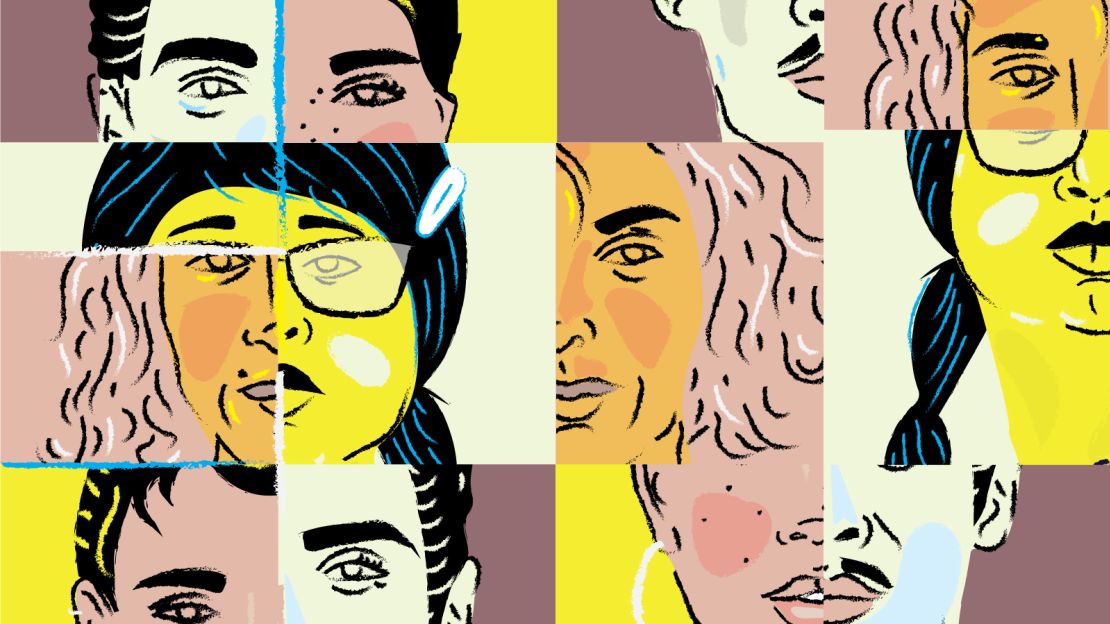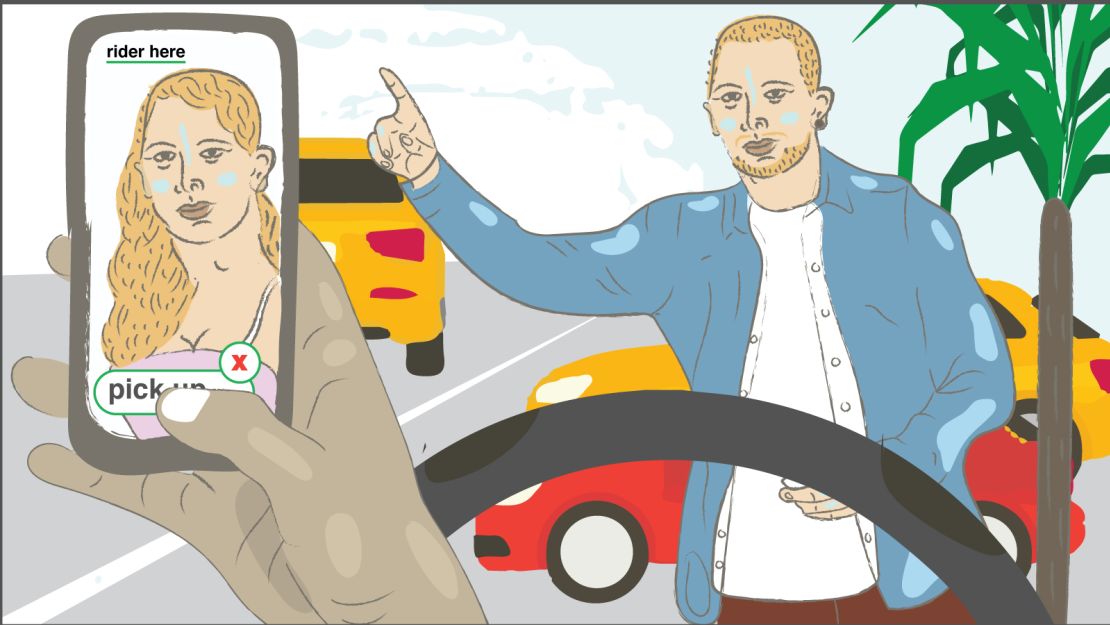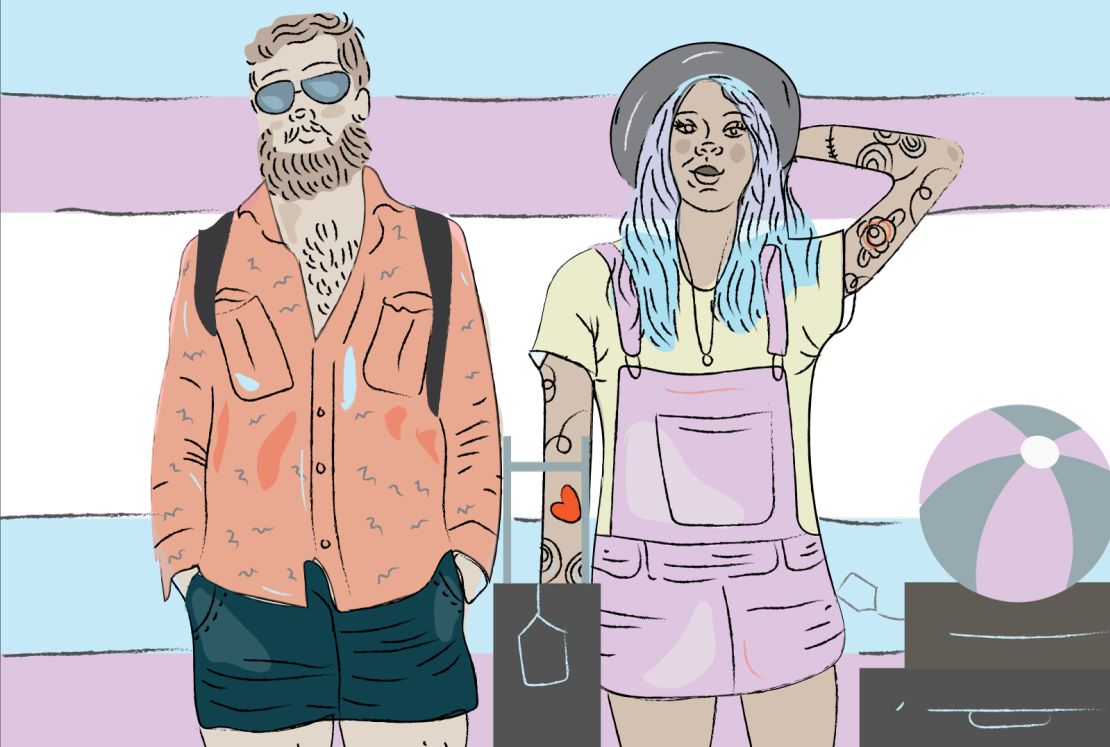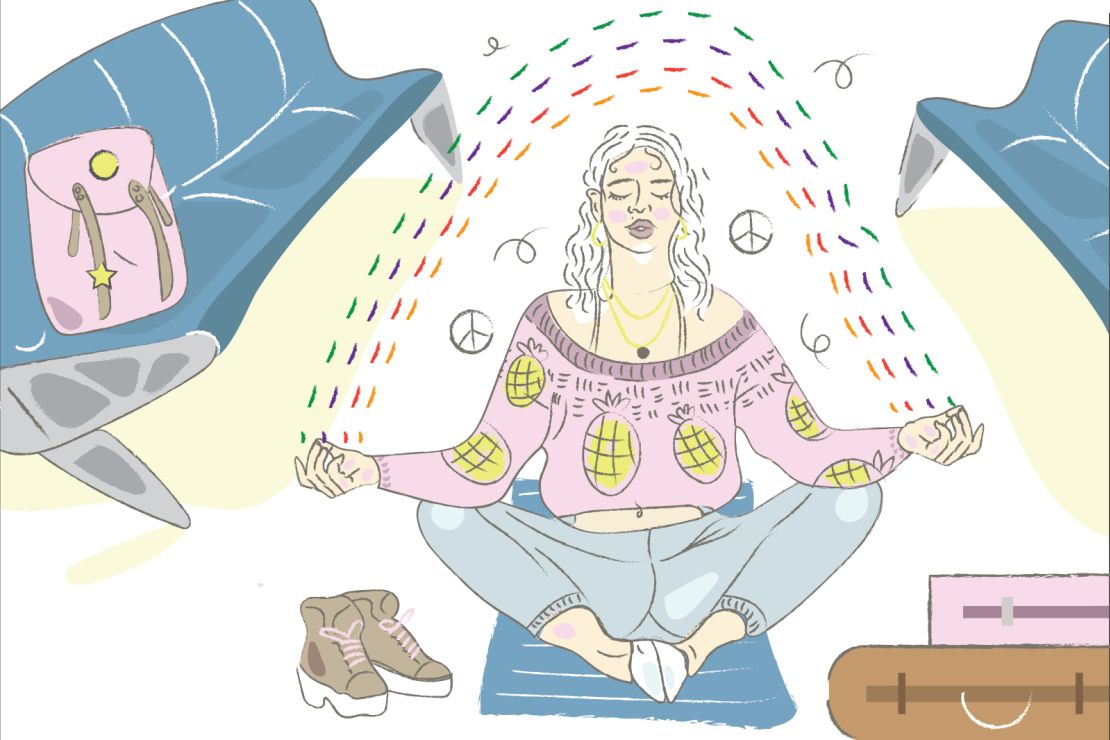Editor’s Note: Some of the people interviewed for this story fear for their safety, so CNN is only using the person’s first name, or a pseudonym, where applicable.
Have you ever felt nervous while raising your arms above your head in the body scanner at the security checkpoint at the airport? Or felt a pang of anxiety as you took the first step out of the airport and into a new country where you don’t know a soul, how to speak the language or which way your hotel is (let alone anything else)?
That fear can feel multiplied for many transgender people when they travel.
The fear was strong enough to keep Melissa Sklarz from leaving the country for more than 20 years. After traveling extensively around the globe in her 20s and 30s, including across Africa and Asia, and even having lived in Israel for three years, she did not leave the United States for more than two decades. What changed?
Her gender, for one, or rather her gender expression — it changed to match the woman she always knew herself to be.
The only problem was that she couldn’t change her identity documents, including her passport, because of restrictive laws. In 2010, under President Obama and Secretary of State Clinton, the U.S. State Department removed a burdensome requirement to provide proof of surgery in order to change one’s gender marker on a passport.
Having a passport that didn’t reflect who she was or how she presented was a risk, according to Sklarz, a sentiment echoed by many transgender people who face the threat of red tape at best and grave harm at worst, when traveling. “I didn’t want to be caught in a situation where if I go off the beaten path, I might be considered a criminal. I was concerned about detention, ignorant officials not understanding my narrative and journey,” Sklarz said. “It would have been a physical and emotional risk.”
After three attempts and nine months following the policy change, Sklarz secured a passport that matched her name and gender; she’s been racking up the frequent flier miles since. “To be able to regain that part of myself is beyond fascinating,” she said.

Trans people as a group face a higher incidence of harassment, frequent discrimination and even violence without leaving their hometowns, much less venturing far beyond them. Within the trans community, trans women and trans women of color especially, deal with these issues at an even higher rate.
Travel adds an exponential unknown to the equation, which can make everything from going through airport security, hailing a cab, renting an apartment, or engaging in an excursion a potential risk.
Of course having the sort of job that requires travel, or the resources to travel for fun, is, itself, a luxury that many trans people – who experience poverty, homelessness and unemployment at rates that far exceed the general population – simply cannot enjoy. And yet, the challenges for trans travelers can be significant.
Flying faux pas
Travel has been fine most of the time for Jules (a pseudonym), who identifies as genderqueer. But Jules has faced gender-related confrontations across nearly all touch points in their travels over the years because of their perceived gender.
There was an uncomfortable Airbnb experience where Jules stacked bags against their door, scared the host might come in during the night (they thought the host was LGBTQ based on several details in the listing, but it turned out to be a straight man and his business partner, who aggressively tried to sell them excursions); and a homophobic cab driver who made Jules so uncomfortable they asked to be let out mid-journey.
Of all the moments of discomfort, harassment or worse that Jules has experienced, though, TSA has won first prize for most frequent offender.
“I scramble their signals and cause a meltdown,” Jules said, referring to the way scanners and pat-downs are often ill-suited to the bodies and sensitivities of passengers who are not cisgender. (The term “cisgender” refers to people whose gender identity aligns with the sex assigned to them at birth.) One time, at an airport en route from New York City to Rochester, a TSA officer grabbed Jules’ chest without warning, mumbling something about how she thought Jules was male but was wrong.
Jules has come to realize that speaking to the TSA officer while going through security causes them to read Jules as female, which, even though it’s not how they identify, has helped reduce the number of pat-downs and heightened scrutiny.

Jules also adopted a cumbersome ritual pre-security to change clothes – removing a binder, a piece of clothing that flattens the chest, because it has caused confusion with TSA officers about whether to process them as male or female – and then changes back after going through the checkpoint.
This has headed off unwanted and invasive scrutiny about Jules’ gender. They say the many negative encounters take a toll over time, and are “harmful to my psyche.”
“Nearly half of those who flew in the previous year experienced problems related to being transgender,” said Harper Jean Tobin, director of policy with the National Center for Transgender Equality, referring to the 2015 U.S. Transgender Survey.
In fact, the TSA plays gender judge to 2.2 million fliers daily without any formal guidelines or training on what constitutes male or female, what the traveler’s preferred gender identity is, or how their sex is reflected on their identity documents, confirmed TSA spokeswoman Lisa Farbstein.
Farbstein relayed that it is at the discretion of individual officers to guess each passenger’s gender, “…based on the gender that individual is presenting.” The agent then selects the corresponding button on the body scanner, which searches for “abnormalities” (a bulge in the crotch area of a person marked female would ring the alarm, for instance).
This has caused numerous problems for transgender travelers, and countless more for people who are non-binary or intersex. (“Non-binary” refers to people who do not identify with either of the two traditional genders, narrowly defined. Intersex people have sex characteristics such as genitals or chromosomes that don’t fit typical binary notions of male or female bodies, according to the United Nations.)
There are recent cases tackling these issues, including an intersex Navy veteran in Colorado who sued (and recently won) to be able to add an “X” marker (to indicate non-binary as the gender identity) to their passport, instead of being forced to choose either male or female.
United Airlines, JetBlue, Delta and other airlines also recently announced they will allow passengers to add non-binary as a gender identity to their tickets.
“We should be able to get on an airplane without having our dignity and identity put on trial by strangers,” said Kris Hayashi, executive director of Transgender Law Center (TLC). If someone has a TSA complaint, according to Hayashi, they can report it to the Department of Homeland Security (though, according to consumer complaint expert Chris Elliott, it may take a long time to receive a response, if you do at all).
You can also reach out to TLC’s Legal Information Hotline.
Screening matters
To avoid body scanners altogether, which can be triggering, some opt for a pat-down, or to travel via other modes of transportation altogether.
Dawn Ennis has generally had positive experiences flying, though she frequently gets a pat-down and has TSA rifle through her belongings and question unfamiliar objects like her vaginal dilator (which trans women commonly use post-gender affirmation surgery). She’s since given TSA a heads up that she has a medical item in her bag in case they detect it.

“I wish there was better education,” Ennis said of TSA. While she says the majority of her experiences have been neutral, she does think TSA agents should be more considerate.
TSA has taken steps to educate their employees and the public about guidelines for screening trans fliers, including a video they released in 2017.
But the video could do more harm than good, according to Dru Levasseur, senior attorney and director of the Transgender Rights Project with Lambda Legal, who told CNN Travel: “I want agencies to do the right thing, but sometimes when you put out a video saying this is what to expect, but then people don’t experience that, it can actually be more harmful.”
Levasseur, who said that calls are “flooding into our help desk from around the country about trauma from TSA,” relayed a heartbreaking anecdote about a colleague he recently met.
The woman, who was transgender (and whose name is being withheld because she recently passed away), was flying from South Africa to Argentina to attend a conference on trans rights when five separate passengers asked to switch seats when they realized a trans person was sitting next to them.
The airline moved the trans woman rather than the passengers who complained (a common, if misguided, de-escalation technique at altitude).
Other transportation travails
The heightened scrutiny of airport security, which seems to create the greatest anxiety and number of incidents for trans and gender non-conforming people, is not the only turbulent stop on the travel journey.
On the afternoon of September 10, 2017, Bethany Grace Howe ordered an Uber en route from a conference in Philadelphia back to the airport so she could return home to the West Coast. The driver pulled up in front of her hotel, asked if she was Bethany, and then shook his head and drove off.

It wasn’t the first time something like this happened to Howe, a trans woman. She reached out to Uber to let them know, but says they didn’t get back to her for a year and a half – and only did so after CNN contacted them for a comment.
(Following CNN’s request for comment, Uber offered Howe a $5 refund for the cancellation fee she paid for the aborted ride, saying that, “…the behavior you’ve described is absolutely not tolerated with the drivers we partner with, and we will be taking action immediately.”)
Uber reached out again the following day to confirm that the driver is no longer with the company and to reiterate their trans-friendly and inclusive policies for both employees and riders.
An Uber spokesperson told CNN: “We believe in fostering a safe and respectful experience for everyone who uses Uber. We have a clear non-discrimination policy for riders and drivers, and continue to invest in technology and processes to enhance our customers’ experience with the app.”
Transportation — whether by air or ground — isn’t the only risk trans or gender non-conforming people face. Once at their destination, particularly in places that are not LGBTQ-friendly, additional concerns abound.
Destination discrimination
When Desiree Escalante, a lesbian who is often mistaken for male, was traveling to the Dominican Republic on vacation to visit family a few years ago, she got into a fender bender in Las Terrenas, a small town in the Samaná province about two hours northeast from the island’s capital of Santo Domingo.
She didn’t think anything of it when the police officers that arrived at the scene asked her to come to the station a couple of blocks away to wait while they processed the paperwork. Minutes after arriving, though, other police officers started to harass her. Asking whether she was a man or woman, they got physically close to her and grew aggressive.
One officer went to the back of the station and removed a woman from a jail cell who had been detained on prostitution charges. “Go tell us if she has a dick or not” they said to the woman, pushing her towards Escalante.
Frightened, Escalante immediately left the station, unsure of what to do next.
“What happened was one of the scariest moments of my life. And while nothing that threatening has ever happened again, the experience made me more conscious of how my gender expression is received by others,” she said.
While she said the incident hasn’t influenced her choices of where to travel, she is more likely to consider traveling with other people.
Mistreatment, including at the hands of law enforcement, isn’t an anomaly. According to the National Center for Transgender Equality’s report, “Reforming Police and Ending Anti-Transgender Violence,” one in five transgender people who interacted with law enforcement reported police harassment.
Add to the mix places where laws do not offer protection on the basis of gender identity or worse, where laws might criminalize their gender identity or expression and cultures where trans rights have not entered the mainstream conversation, and international travel can become a very vulnerable experience for someone who is trans or gender non-conforming.
“Some trans people are prisoners in their own home country because they are afraid of being subjected to the trauma or humiliation they may face when traveling through TSA or globally,” Levasseur said.
Keeping U.S. consulate contact information handy and traveling with a companion can help. Knowing the local laws and customs is also important, as is always being aware of the surroundings to steer clear of potentially threatening encounters.
Hotel and rental property harassment
When it comes to hotels and rental properties, you should have some blanket protections if traveling to a destination that has local laws barring discrimination on the basis of gender identity or expression, or booking with a major chain that has inclusive policies, as many Fortune 500 American-owned hotel chains do.

Of course, that doesn’t mean the day-to-day is sure to be free from negative encounters, especially if you’re traveling somewhere that is generally hostile to LGBTQ people. Taking steps like renting a standalone property rather than a room in a house with other people can help reduce risk.
One of the most publicized instances of discrimination in the so-called “sharing economy” involved animator and producer Shadi Petosky, who was turned away from an Airbnb property in 2015 by the host because she is transgender.
Airbnb initially did not respond to the complaint. One year later when Petosky’s tweets on the incident vent viral, the company replied to say it was removing the host from its network and tweeted its commitment to inclusivity stating, “discrimination has no place in the Airbnb community.”
“I have a lot of privilege in travel,” Petosky tweeted. “Just adding to the knowledge that the sharing economy can/does discriminate.”
In a statement to CNN, Airbnb confirmed that they have since removed the host from their platform and increased efforts to work with the LGBTQ community, which is reflected in their nondiscrimination policy. “People who violate this policy may be permanently banned from using Airbnb,” Airbnb spokesperson Jasmine Mora said.
What can we do to help?
Nearly every trans and gender non-conforming person CNN Travel spoke with has travel horror stories, whether it’s being misgendered, harassed or worse. No stage of the journey is free from the possibility of something negative happening simply because of the pervasiveness of transphobia in society.
Cisgender people can be good allies by bearing witness, helping to educate others, and, when possible, stepping in to intervene when something unjust is happening.
“The world is shifting around transgender and non-binary people,” said Levasseur. “It’s great that their identities are being validated, but there are gaps between policy changes and the world’s understanding and safety net. What does that mean when trans people want to travel?”
8 safety tips for trans people while traveling
Jill Marcellus, director of communications at the Transgender Law Center, and Harper Jean Tobin, director of policy at the National Center for Transgender Equality, offer the following travel guidance:

1. Consider the letter and spirit of non-discrimination laws at your destination: Know whether there are any travel warnings at your destination and know whether national and local laws are inclusive. Consider avoiding or being extra vigilant in places where LGBTQ rights are not protected.
2. Review your ID documents: Bring original copies of court name change certificates and backup copies of relevant legal and other documents, in case you need to present them. Make sure that the name and gender on your reservation match the ID you plan to travel with.
3. Read TSA’s guidelines: TSA has a number of additional steps you can take to protect yourself, including to download a TSA Notification Card and hand it to the officer at the screening for a more discreet alert, or call 855-787-2227 for advanced notice or to request a passenger support specialist (noting that the latter may not yield useful results). Full guidelines online. TSA also confirmed that you can request a private screening/pat-down and that you are legally allowed to bring a companion in with you.
4. TSA PreCheck: “No one should have to pay extra for basic human dignity,” said Tobin. “But with things as they are, joining TSA’s PreCheck program can reduce the likelihood of screening problems for trans travelers.”
5. Carry-on vs. checked luggage? Medical equipment and prosthetics will be allowed through the checkpoint after completing the screening process, but some travelers may feel more comfortable putting these things in checked baggage. Gel-filled prosthetic items such as breast forms are not included in the three-ounce liquid limit for carry-ons, as they are considered medically necessary, but their presence in your carry-on luggage may result in extra screening. If possible, consider packing items containing liquid, gel or powder in your checked luggage.
6. Security checkpoints: Foreign objects such as prosthetics, binding garments, or even paper or change left in a pocket will commonly register as anomalies requiring further screening. Often this consists of a limited pat-down of the area(s) where an anomaly was detected, however it can potentially involve a complete pat-down. You may opt out of AIT (full-body) scans at any time, but if you do opt out of AIT screening, you will be required to undergo a thorough pat-down.
7. Know your rights: Read up on what your rights are in a given situation, from airport security to passport control, in a public accommodation and anywhere you’re traveling. Knowing what you’re allowed to refuse, what you can say and what legal recourse you might have in a given situation will help guide you safely and more confidently.
8. Pack your Zen: Travel is one of the most enriching and wonderful privileges, but it can also be incredibly stressful for LGBTQ people. If you are trans or gender non-conforming, traveling can present uncomfortable and emotionally-heightened scenarios. Staying calm, however difficult, will help neutralize situations that could quickly escalate.
“We encourage you to assert your rights in a positive and respectful manner. At the same time, we strongly encourage you not to get in a confrontation with TSA personnel if at all possible,” according to National Center for Transgender Equality’s Know Your Rights, Airport Security page.
Allison Hope is a writer and native New Yorker who favors humor over sadness, travel over television, and coffee over sleep. Follow Allison on Twitter @bubballie



















